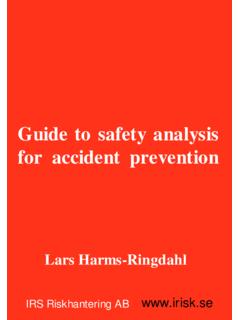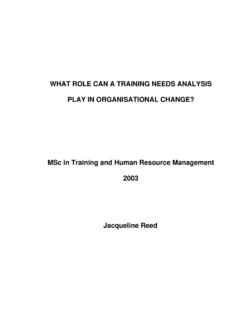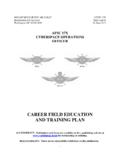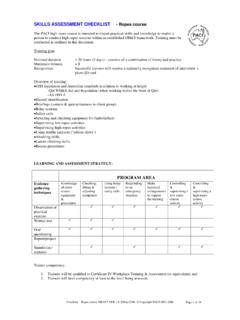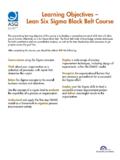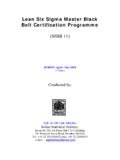Transcription of Analysis of safety functions and barriers in accidents
1 Preprint version: Analysis of safety functions and barrier in accidents safety Science 47 2009 Lars Harms-Ringdahl, 2009 1 Preprint version safety Science 47 (2009) 353 363 Analysis of safety functions and barriers in accidents Lars Harms-Ringdahl a, b a) Institute for Risk Management and safety Analysis , Bergspr ngargr nd 2A, SE-116 35 Stockholm, Sweden b) Karlstad University, Department of Public Health Sciences, SE-651 88 Karlstad, Sweden e-mail: Abstract A new method for accident investigations is presented. It is based on the concept of safety function, which is defined as a technical or organisational function, a human action or a combi-nation of these, that can reduce the probability and/or consequences of accidents and other unwanted events in a system.
2 An Analysis starts with the identification of safety functions related to the event. These are structured; an assessment is then made of whether they worked or not, and finally safety improvements are proposed. The method has been applied to five different incidents, coming from different types of work sites, such as electrical power distribution, a railway, and hospitals. For each case, around 40 safety functions were identified, of which less than half had worked. It was found that technical, organisational and human safety features existed side-by-side. The method supports a consistent Analysis of a variety of safety features, and can integrate them into a common format. Each system contained formal and informal elements in parallel, often overlapping. This can be seen as safety redundancy, which makes the safety system less vulnerable to change that supports the preservation of safety .
3 It might be more adequate to describe this as a safety web rather than a distinct set of barriers , and there is also an analogy with the concept of safety resilience. Keywords accident Analysis , Barrier, Incident Analysis , Organisational factor, Resilience, safety function 1 Introduction The main target of an accident investigation is usually to explain the course of events. An essential question is how the event could have happened. In most systems, especially in the case of large hazards, there are several safety features in place to prevent accidents from occurring. Accordingly, an essential complementary aim of any investigation should be to analyse how the safety system failed. For a long time, there has been considerable interest in the modelling and Analysis of safety features and accident prevention.
4 However, concepts and terminology related to safety features vary considerably ( Sklet, 2006), causing confusion and difficulties in comparing different approaches. There are a number of accident investigation methodologies, which more or less explicitly include barriers and other safety features, and their roles in the course of an accident . Interest has been especially great in the off-shore, chemical, and nuclear industries, and accord-ingly research has been heavily oriented towards major hazard installations ( Hale, 2006; Sklet, 2006). There are many research challenges in areas with complex technical and organisa-tional settings, which require sophisticated methods and models to further improve preventive measures. Preprint version: Analysis of safety functions and barrier in accidents safety Science 47 2009 Lars Harms-Ringdahl, 2009 2 However, this type of industry and these safety aspects represent only a small fraction of the field of accident prevention.
5 Common workplaces, and to an even larger extent out-of-work situations, produce many more injuries and fatalities than major hazard industries. Despite this, the Analysis of barriers and other safety features has received less attention in these types of situations. The transfer of methods from high-risk areas is not uncomplicated, since they represent different kinds of conditions (Harms-Ringdahl, 2004). There are several contributing elements to the safety level at the workplace, with technical and organisational safety features functioning together. Social factors and informal behaviour can also contribute in essential way. These considerations have formed an interest to combine technical and formal as well as infor-mal organisational safety features in a consistent framework, which needs to be multidiscipli-nary.
6 This has also been a major motive for further developing barrier concepts and method-ologies for fairly simple settings. This paper is concerned with how safety characteristics can be modelled and evaluated on the basis of information from accidents and incidents. Its principal aims are to present a method that applies the concept of safety function and to demonstrate how it works in practical accident investigations. A further objective is to present the results that can be obtained from such investigations. The method is intended to give information about the incident and circumstances at the actual workplace. The results can be used for improvements and learning locally. First after the application on several incidents, more general conclusions can be drawn. The paper is based on experiences from earlier studies of barriers and safety functions , and is founded in a gradual development.
7 The author has had earlier favourable experiences of applying the generic concept of safety function in safety Analysis (Harms-Ringdahl, 2001, 2003a, 2003b). The main attention is on common workplaces rather than major hazard installa-tions. The term accident is used for simplicity, but near- accidents and other unfavourable events are also addressed. 2 Concepts and methods Concepts of barriers and safety functions safety barriers There are many approaches to the description of safety characteristics in systems, and terms like barriers and defences are often used to describe them. Energy models have been used for a long time ( Johnson, 1980), and they usually involve technical as well as organisational barriers . Examples are the containment of a chemical substance, and the maintenance procedure of the container.
8 A common term is defence, which is defined by Reason (1997) as various means by which the goals of ensuring the safety of people and assets can be achieved . A division has been made between hard defences, such as physical barriers and alarms, and soft defences regula-tion, procedures, and training. Defence is a wider concept than that of barriers . The same reference also refers to defence-in-depth as successive layers of protection . One approach is to focus on the accident sequence and how it can be interrupted. One example is barrier function, which represents a function that can arrest the accident evolution so that the next event in the chain will not be realized (Svenson, 1991). A barrier function is identified in relation to the system(s) it protects, has protected, or could have protected.
9 Preprint version: Analysis of safety functions and barrier in accidents safety Science 47 2009 Lars Harms-Ringdahl, 2009 3 A comprehensive review by Sklet (2006) found that there is no universal and commonly accepted definition of terms like safety barrier, defence, defence in-depth, layer of protection, safety function, either in the literature, or in regulations and standards. Sklet s review suggests that distinctions should be made between the terms barrier and barrier function , which easily can be confused. Based on his review, Sklet (2006) suggests three definitions related to safety barriers . safety barriers are physical and/or non-physical means planned to prevent, control, or mitigate undesired events or accidents ; A barrier function is a function planned to prevent, control, or mitigate undesired events or accidents ; A barrier system is a system that has been designed and implemented to perform one or more barrier functions .
10 According to Sklet, the barrier function describes the purpose of safety barriers , and it should have a direct and significant effect. A barrier function should preferably be defined by a verb and a noun, Close flow . According to this set of definitions, a function that has an indirect effect is not classified as a barrier function, but as a risk influencing factor/function. The definitions relate to well-defined system, which are carefully planned and designed, and as Sklet points out they refer to major hazard installations. safety functions safety function is a rather common term, which is used in different situations. However, it is hard to find general definitions in the literature. One highly specialized characterization is given in the standard about electrical/electronic /programmable electronic (E/E/PE) systems (IEC, 2001).
